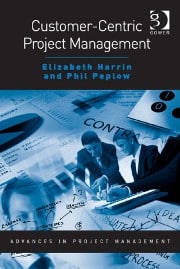6 Barriers to customer centricity
This blog is reader-supported. When you purchase something through an affiliate link on this site, I may earn some coffee money. Thanks! Learn more.
This is an edited extract from Customer-Centric Project Management by Elizabeth Harrin and Phil Peplow (Gower/Routledge, 2012).
It would be great to think that project-based organizations and PMOs would jump at the opportunity to improve stakeholder engagement and project communication by demonstrating customer centricity (not sure what that is in the context of project management? Find out what customer-centric project management is here).
However, there are likely to be some concerns about doing things differently, which will manifest themselves as barriers to a successful implementation of a customer-centric approach.
We have identified 6 barriers to fully adopting a customer centric approach. They are:
- Time
- Transparency
- Team
- Title
- Type of organization
- Technique
Let’s look at each of those in turn.
Time
There have been times when more hard-headed and sceptical business leaders have stated that they have no time for a monthly customer satisfaction meeting.
This is not a problem – conference calls can be used successfully. Issues can be agreed, status discussed, priorities defined and customer satisfaction scores obtained in a 15–minute phone call. You can even gather their feedback over email if necessary.
Experience has shown that once successes have been delivered and the customer sees evidence that the process delivers real benefit to them, face-to-face meetings follow very quickly at the customer’s request.
Transparency
Some leaders are adverse to the idea of anything that sheds light on what could be seen as a poorly-performing business unit. The process of gathering customer satisfaction scores that relate to how well the project manager and team are delivering comments on the level of project management maturity in the organization.
Fear that it is not as good as you had hoped can be a barrier to implementing this type of feedback loop. Honesty is essential for the process to be successful and having access to this data across a number of projects will provide a way to run a health check on projects.
Remember, if you don’t know how customers see their projects, project managers and their supporting PMO organization are not able to undertake course correction actions before the situation for the customer becomes untenable.
Transparency can also manifest itself in cultural issues. Team members or project customers from cultures that value harmony above transparency may find it difficult to share their honest thoughts during this process.
Team
If one project manager consistently receives excellent customer satisfaction scores, and another does not, this is one way to distinguish between which project managers are well thought of in the organization and which are not. However, this can be a dangerous approach to take, as project customers and their requirements vary significantly from project to project.
A project manager who consistently receives average scores could be one of the top performers in the company, and as such is repeatedly assigned the more challenging projects and stakeholders. This will be reflected in the scores.
Project managers will soon realize that scores can differ due to factors beyond their control and could be concerned that this will reflect badly on them. They may be resistant to the introduction of a customer satisfaction program, even though they may support the concept of customer centricity.
A way to handle this is for the PMO to reassure project managers that scores will not be used to rank project managers. Of course, you then have to follow through on this – don’t produce ranking of assessment data behind the scenes.
Consideration should always be given to the context that the scores are received in. If this does not happen, the information provided will become unreliable as project managers seek to find ways around or out of carrying out satisfaction reviews. This is very much against the spirit of customer-centric project management.
Title
Customer satisfaction reviews are not just the project manager’s role. The process is simple, and once you have the mindset of customer-centric project management and a couple of templates, it’s easy enough for anyone to do. Don’t limit customer satisfaction reviews to only those people with the job title of project manager, or any other individual title.
Equally, don’t let project team members use the fact that they do not have the title of project manager as reason to not adopt customer-centric project management principles or take an active part in customer satisfaction reviews.
Type of organization
In Researching the Value of Project Management (Thomas, J. and Mullaly, M. 2008. Researching the Value of Project Management. Newtown Square: PMI), Janice Thomas and Mark Mullaly identified two types of project management culture. Project management was either seen as a tool for control or a leadership discipline.
Organizations with a project management culture that leans towards adherence to process, structure and policing of control mechanisms are likely to struggle implementing any customer-centric approach, despite it being essentially another project management process.
They will likely lack the flexibility to respond appropriately to the output of customer satisfaction meetings and may be resistant to project managers having these discussions at all.
Companies where project managers are seen as leaders and personal development is encouraged are likely to find lower barriers to resistance when implementing customer-centric project management techniques.
A corporate culture that supports sharing of information and emphasizes coaching, mentoring and developing individuals is likely to consider customer satisfaction reviews as another opportunity to grow the capabilities of staff members.
Technique
In order to have meaningful conversations with project customers, project managers need to be equipped with the soft skills required to approach these conversations with confidence and emotional intelligence.
All these barriers can be overcome, so that your projects, with a bit of help, can become truly customer-centric.
Buy Customer-Centric Project Management on Amazon.co.uk
This article first appeared on this website in 2013.

